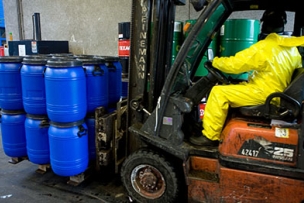The Link Between Industrial Hygiene, Safety and Employee Absenteeism
OSHA gives the dirt on dirt at work. Learn where to focus your safety and health program when it comes to causing or spreading illnesses on the job.
Industrial hygiene is the science of anticipating, recognizing, evaluating and controlling workplace conditions that may cause workers injury or illness. According to the Occupational Safety and Health Administration, more than 4 million workers suffer some type of job-related injury or illness each year, resulting in huge cost implications for businesses.
“Most employers want to do everything they possibly can to minimize this [job-related injury or illness], but there are still things that can be done–and done better–to reduce those numbers,” says Glenn Taylor, assistant regional administrator for compliance programs at OSHA, Region 7.
OSHA considers an injury or illness to be work-related if “an event or exposure in the work environment either caused or contributed to the resulting condition or significantly aggravated a pre-existing condition.”
“The shop floor at a manufacturing facility can be a very dusty, dirty and grimy place,” Taylor says. “The fact that something has dirt on it doesn’t mean it’s necessarily hazardous, but if you walk in the door and see a lot of dirt and dust, that could be indicative of other, more serious industrial hygiene matters.”
Reduce Absenteeism with Better Flu Hygiene
The most obvious result of a lack of hygiene at work is the spread of contagious diseases among workers, especially the flu virus. Workers who may just be coming down with the flu, or who come to work even when they are sick, unwittingly contribute to the spread of the virus.
“During flu season, frequent, proper hand washing, with soap or an alcohol-based rub, is critical,” Taylor says. “Workers may have touched their nose or mouth, and then touched door handles, phones and copy machines–which become ‘vectors’ that can actually pass on infectious particles.”
Commonly touched work surfaces, countertops, lunch tables and doorknobs that are used by multiple people should be kept clean and periodically wiped with disinfectant according to the manufacturer’s guidelines, Taylor says.
According to a whitepaper from the American Institute for Cleaning Sciences (ISSA), a business incorporating the “Wash, Wipe, Sanitize” protocol of the Healthy Workplace Project, sponsored by Kimberly-Clark Professional, can reduce absenteeism by as much as 46 percent.
Workplace Hygiene Beyond the Flu
Occupational illnesses due to lack of workplace hygiene could include: skin diseases or disorders caused by exposure to chemicals or other substances; respiratory illnesses–such as silicosis, COPD, and metal fume fever–associated with breathing hazardous chemicals, dust or fumes; poisoning by toxic substances, such as lead, organic solvents or other chemicals; as well as more serious bloodborne pathogenic diseases including hepatitis B or C and HIV.
“If a company is producing toxic dust as a result of a work process, and that dust is getting in the air, there may be a potential for silicosis or pneumoconiosis,” says Taylor. “Or, if somebody is out working with lead, and their clothing or boots or hands have lead particles on them, and they don’t wash adequately and remove the contaminated articles prior to going into the lunchroom to eat, they could be ingesting lead, as well as breathing it in.”
Some hazards, such as flu, are acute, while others, such as silicosis or lead poisoning, can be chronic or long term after years of exposure on the job–even at levels just under the permissible exposure limit, Taylor says.
“Most employers want to do everything they possibly can to minimize this [job-related injury or illness], but there are still things that can be done–and done better–to reduce those numbers.”
The Need to Adopt Targeted Safety and Health Programs
In order to prevent absenteeism caused by lack of workplace hygiene, OSHA recommends each company implement a safety and health program.
“The key things to address with any kind of program are getting management involved in providing leadership, getting workers involved in participating, and developing a process or approach to finding and fixing hazards in the workplace,” Taylor says.
“For example, assessing exposure of workers to the dust environment may involve personal sampling and area sampling, to determine their exposure levels and whether it be just nuisance dust, or dust of a toxic nature,” says Taylor. “Based on that, they would have to look at controlling that hazard, by substituting another material, modifying the machinery, installing improved ventilation, or requiring PPE respirators.”
Small- and medium-sized companies can get free consulting help for assessing hazards, creating a safety and health program, and training their employees through their state’s department of labor under the OSHA Act Section 21(d) program.
A safety and health program will reduce injuries and illnesses and will also reduce absenteeism and the associated costs, including workers’ compensation and training of replacement workers–resulting in greater profits for the company.
“If their businesses are saving money and improving their safety and health performance, they’re going to be more competitive in their industry, as compared with a company that doesn’t have a good program,” Taylor says.
How do you educate your workforce on the best practices in hygiene? Share what you do.




Talk to Us!
Leave a reply
Your email address will not be published. Required fields are marked *